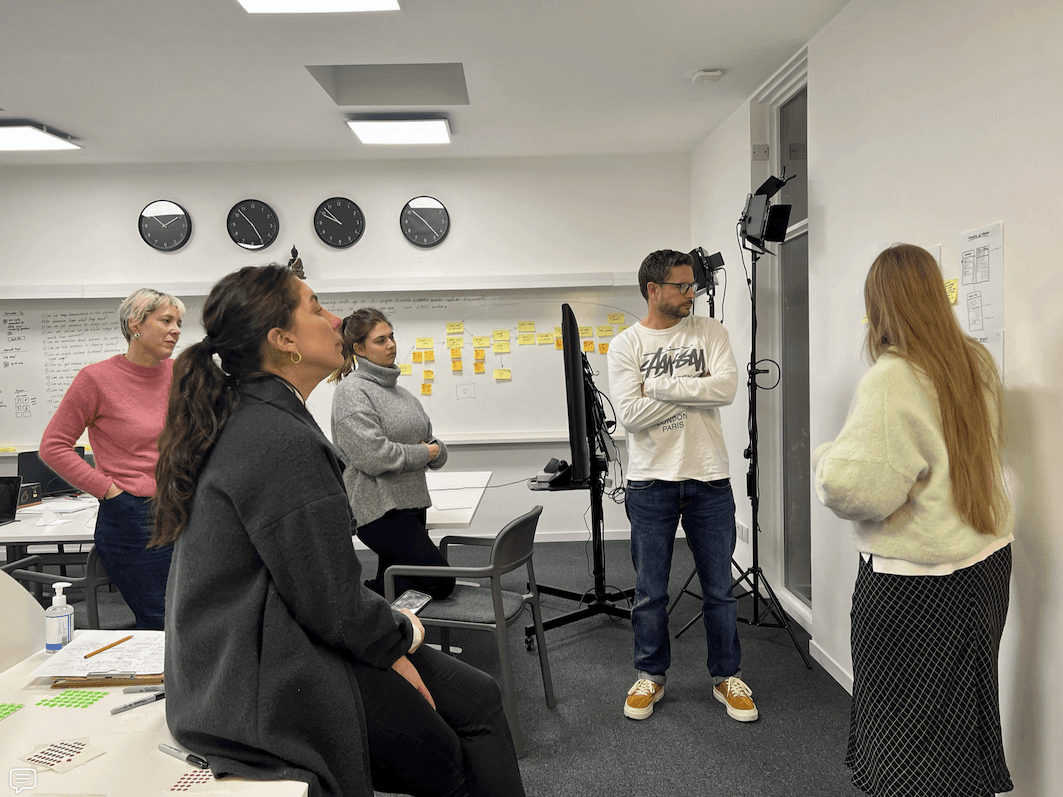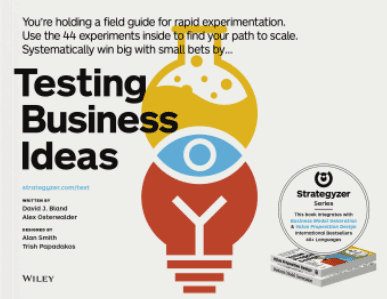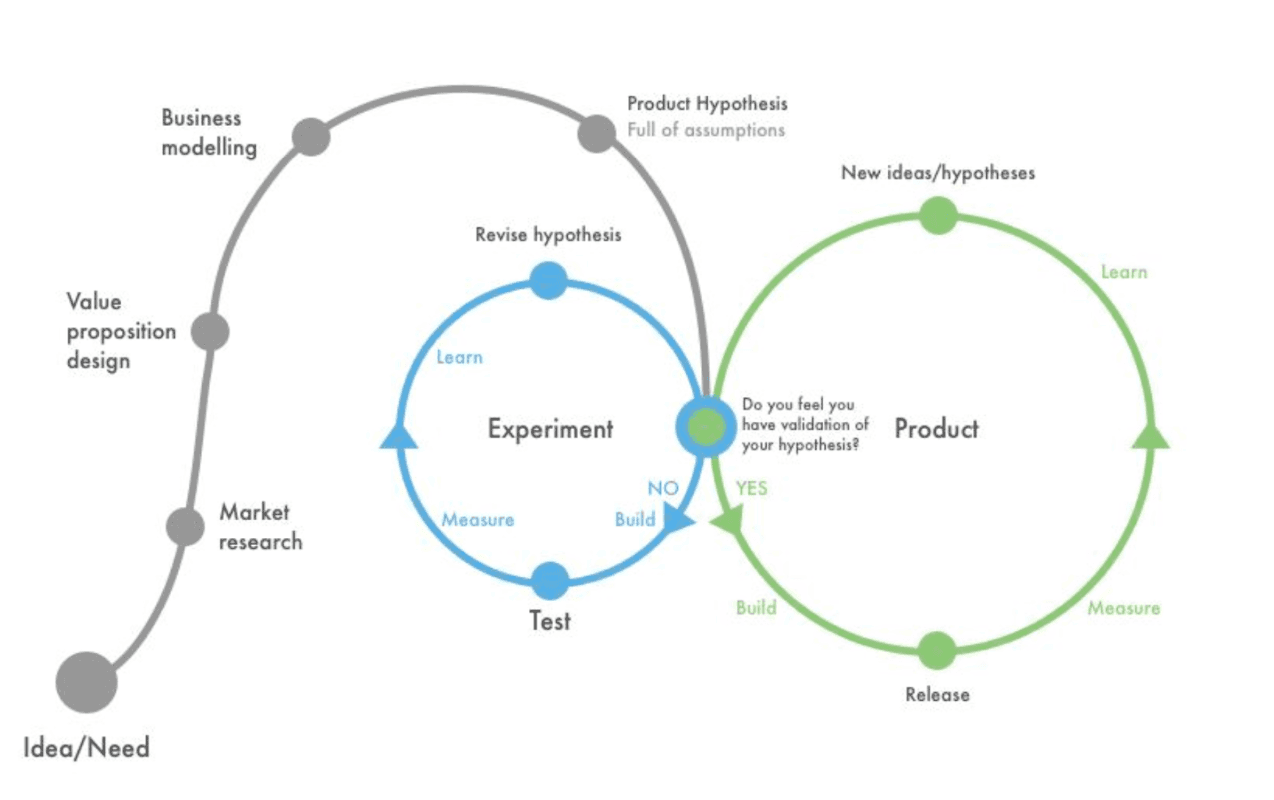Activate Studio is accepting startup applications for the Winter 2025 funding cycle. The deadline for submission is Wednesday, December 31st.
Activate Studio is accepting startup applications for the Winter 2025 funding cycle. The deadline for submission is Wednesday, December 31st.
Activate Studio is accepting startup applications for the Winter 2025 funding cycle. The deadline for submission is Wednesday, December 31st.
Got an Idea You Want to Turn Into a Product?
22 Apr 2022

Here’s how our Startup Studio can help
Every journey from an idea to a successful product is unique. It will depend on your experience, your resources, your partners, your timing and many other factors, including luck.
At Activate’s Startup Studio, we tailor our work around each new idea and team of founders we decide to engage with. While there isn’t a one-size-fits-all recipe, here are some of the most common steps in the journey of most founders from idea to a sustainable product.
Figure out why you are doing this
Starting a business is one of the most important decisions you will make in your life. Creating a company is hard. Creating a successful company is even harder.
And it won’t be quick: on average, it takes 7 to 10 years for a startup to go from an original idea to an exit phase. During this time, you will have to engage with investors, partners, employees, clients and all other stakeholders: it will be exhausting, it will be frustrating most of the time, but there will be some amazing moments.
If you still think you want to do this, you must have a clear idea of your life goals. What do you expect to get out of this? A house? A yacht? A trip to Mars? How could this impact the lives of many different people? If there are multiple founders in your company, it’s critical that you have this discussion together early on so that it’s clear to all involved how much it will take and where you are planning to go.
An interesting tool you can use is the WealthBeing Calculator. It will give you an idea of how much your business idea will need to grow to get you to the financial goals you have.
Find help (for example, a Startup Studio)
You will need all the help you can find to turn your original idea into a viable product. These days there are a lot of organisations out there that help founders launch their new companies: accelerators, incubators, mentors, coaches, startup studios. We all do similar things in different ways.
You should find people who understand you and who you want to work with, with experience in the type of business you are developing and with appropriate resources to help you.
Don’t just accept the first offer you get, whoever you find, make sure that you’ll be comfortable working with them for a significant part of your journey.

Understand your future clients
You have an idea. It’s not just an idea, it’s a great idea. It’s revolutionary. But if you can’t convince your clients to give you money in exchange, you don’t have a viable business.
Spend as much time as you can researching your future clients, fact-checking your hypothesis, questioning your assumptions, refining your project.
There are many ways to test your business ideas, Testing Business Ideas is a good book to start from.

Focus on your Value Proposition
Once you have a better idea of your clients and how your market is segmented, go back to your product and focus on your value proposition. Find out which is the minimum amount of product or service you can give to your clients which will still be helpful to them (and possibly they will be willing to pay for).
Once you have removed everything you can from your product, you should get to what we call Minimum Viable Value Proposition. This will be the first version of your product.
Write a business plan
Now that you know who to market to and what to build, it’s time to make a plan. A business plan doesn’t have to be too complicated, you can use a Business Model Canvas or one of the other tools available online to create one.
One of the most important things to consider is to build a credible hypothesis of your business and be prepared to defend it: your ability to persuade others of your vision will determine your success.
Raise capital
In order to build a product, you need capital. You will need to summarise your vision, strategy and product in a pitch deck, and then start meeting investors.
The good news is that there are a lot of investors in the UK, and there are some very good incentives to invest in startups (make sure you know everything about SEIS and EIS before you go).
The bad news is that every investor is unique: they will be investing for their own reasons, decide based on vastly different experiences and have assorted ways to consider risk.
You will have to adapt your pitch deck and your presentation for different target audiences. Most probably, in the beginning, you will not be good, and you will improve after every pitch. Remember that this is a marathon, not a sprint. It is not rare that founders have to pitch 30 to 50 times before they raise all the capital they need.
Build your product team
Collaboration within your product team is the key to your success. Firstly, you will need to decide who plays the role of product manager. This can be one of the co-founders or somebody you will hire, but you simply can’t proceed before filling this role.
The product manager will connect your business strategy with the design and development cycle and will have authority on all product decisions.
Building a modern digital platform requires a vast range of skills, from different types of software developers, to designers, to QA engineers, to devops engineers, etc. Then, you will need help from other parties: marketing consultants, data scientists, analytics experts.
You will have to orchestrate all these talents and personalities to avoid the emergence of factions within different teams. While this can be annoying within corporate environments companies, it kills startups.
Start your product cycle
This illustration describes the process we use at Activate Studio:

The important idea in the product design and development cycle is that these two processes continue iterating indefinitely. You don’t design a product, then you build it, then you are done. You will continue to design, build, and improve your product for as long as your company exists
Go live!
This is a very good post by Matt Mullenweg, the founder of WordPress, about what version 1.0 of any product should be.
You will not be happy with it. It will have too few features and way too many bugs to make you comfortable. But hopefully, it will deliver a value proposition to your customers. It will be just a first iteration, it will give you huge opportunities to learn from your users and improve at any iteration.
Listen, keep running your product cycle
The good news is that version 1.1 will be a bit better. Version 1.2 even more. By the time you get to version 2.0 you will probably have the product you thought you would have released with version 1.
While you improve your product, you will have to optimise many other aspects of your business: from your marketing strategy to your operations, from finance to legal.
But with a product on the market, you will finally be able to focus on your next goal: getting traction!
Raise more capital
At your first round, you should have raised enough capital to build a product, go to market and run a few iterations. Ideally, you will have convinced a certain number of customers to pay, and figured out how to find more of them.
But most likely, you are not profitable enough to be able to sustain all your costs and grow your business.
It’s time to go out and raise again.
You will have maintained good relations with your previous investors: not only sending email updates every once in a while, but talking with them about your business: remember that they believe in you. This means that theirs will be the first doors to knock on. And then there will be more networking, more pitch decks, more presentations… and the whole cycle will repeat.
If you are interested in getting some help from the Activate Studio in your journey from idea to launch, apply to become one of our portfolio companies here.
Here’s how our Startup Studio can help
Every journey from an idea to a successful product is unique. It will depend on your experience, your resources, your partners, your timing and many other factors, including luck.
At Activate’s Startup Studio, we tailor our work around each new idea and team of founders we decide to engage with. While there isn’t a one-size-fits-all recipe, here are some of the most common steps in the journey of most founders from idea to a sustainable product.
Figure out why you are doing this
Starting a business is one of the most important decisions you will make in your life. Creating a company is hard. Creating a successful company is even harder.
And it won’t be quick: on average, it takes 7 to 10 years for a startup to go from an original idea to an exit phase. During this time, you will have to engage with investors, partners, employees, clients and all other stakeholders: it will be exhausting, it will be frustrating most of the time, but there will be some amazing moments.
If you still think you want to do this, you must have a clear idea of your life goals. What do you expect to get out of this? A house? A yacht? A trip to Mars? How could this impact the lives of many different people? If there are multiple founders in your company, it’s critical that you have this discussion together early on so that it’s clear to all involved how much it will take and where you are planning to go.
An interesting tool you can use is the WealthBeing Calculator. It will give you an idea of how much your business idea will need to grow to get you to the financial goals you have.
Find help (for example, a Startup Studio)
You will need all the help you can find to turn your original idea into a viable product. These days there are a lot of organisations out there that help founders launch their new companies: accelerators, incubators, mentors, coaches, startup studios. We all do similar things in different ways.
You should find people who understand you and who you want to work with, with experience in the type of business you are developing and with appropriate resources to help you.
Don’t just accept the first offer you get, whoever you find, make sure that you’ll be comfortable working with them for a significant part of your journey.

Understand your future clients
You have an idea. It’s not just an idea, it’s a great idea. It’s revolutionary. But if you can’t convince your clients to give you money in exchange, you don’t have a viable business.
Spend as much time as you can researching your future clients, fact-checking your hypothesis, questioning your assumptions, refining your project.
There are many ways to test your business ideas, Testing Business Ideas is a good book to start from.

Focus on your Value Proposition
Once you have a better idea of your clients and how your market is segmented, go back to your product and focus on your value proposition. Find out which is the minimum amount of product or service you can give to your clients which will still be helpful to them (and possibly they will be willing to pay for).
Once you have removed everything you can from your product, you should get to what we call Minimum Viable Value Proposition. This will be the first version of your product.
Write a business plan
Now that you know who to market to and what to build, it’s time to make a plan. A business plan doesn’t have to be too complicated, you can use a Business Model Canvas or one of the other tools available online to create one.
One of the most important things to consider is to build a credible hypothesis of your business and be prepared to defend it: your ability to persuade others of your vision will determine your success.
Raise capital
In order to build a product, you need capital. You will need to summarise your vision, strategy and product in a pitch deck, and then start meeting investors.
The good news is that there are a lot of investors in the UK, and there are some very good incentives to invest in startups (make sure you know everything about SEIS and EIS before you go).
The bad news is that every investor is unique: they will be investing for their own reasons, decide based on vastly different experiences and have assorted ways to consider risk.
You will have to adapt your pitch deck and your presentation for different target audiences. Most probably, in the beginning, you will not be good, and you will improve after every pitch. Remember that this is a marathon, not a sprint. It is not rare that founders have to pitch 30 to 50 times before they raise all the capital they need.
Build your product team
Collaboration within your product team is the key to your success. Firstly, you will need to decide who plays the role of product manager. This can be one of the co-founders or somebody you will hire, but you simply can’t proceed before filling this role.
The product manager will connect your business strategy with the design and development cycle and will have authority on all product decisions.
Building a modern digital platform requires a vast range of skills, from different types of software developers, to designers, to QA engineers, to devops engineers, etc. Then, you will need help from other parties: marketing consultants, data scientists, analytics experts.
You will have to orchestrate all these talents and personalities to avoid the emergence of factions within different teams. While this can be annoying within corporate environments companies, it kills startups.
Start your product cycle
This illustration describes the process we use at Activate Studio:

The important idea in the product design and development cycle is that these two processes continue iterating indefinitely. You don’t design a product, then you build it, then you are done. You will continue to design, build, and improve your product for as long as your company exists
Go live!
This is a very good post by Matt Mullenweg, the founder of WordPress, about what version 1.0 of any product should be.
You will not be happy with it. It will have too few features and way too many bugs to make you comfortable. But hopefully, it will deliver a value proposition to your customers. It will be just a first iteration, it will give you huge opportunities to learn from your users and improve at any iteration.
Listen, keep running your product cycle
The good news is that version 1.1 will be a bit better. Version 1.2 even more. By the time you get to version 2.0 you will probably have the product you thought you would have released with version 1.
While you improve your product, you will have to optimise many other aspects of your business: from your marketing strategy to your operations, from finance to legal.
But with a product on the market, you will finally be able to focus on your next goal: getting traction!
Raise more capital
At your first round, you should have raised enough capital to build a product, go to market and run a few iterations. Ideally, you will have convinced a certain number of customers to pay, and figured out how to find more of them.
But most likely, you are not profitable enough to be able to sustain all your costs and grow your business.
It’s time to go out and raise again.
You will have maintained good relations with your previous investors: not only sending email updates every once in a while, but talking with them about your business: remember that they believe in you. This means that theirs will be the first doors to knock on. And then there will be more networking, more pitch decks, more presentations… and the whole cycle will repeat.
If you are interested in getting some help from the Activate Studio in your journey from idea to launch, apply to become one of our portfolio companies here.
Got an idea for a business based on a digital platform?
Activate Studio is accepting startup applications for the Winter 2025 funding cycle. The deadline for submission is Wednesday, December 31st.
Got an idea for a business based on a digital platform?
Activate Studio is accepting startup applications for the Winter 2025 funding cycle. The deadline for submission is Wednesday, December 31st.
Got an idea for a business based on a digital platform?
Activate Studio is accepting startup applications for the Winter 2025 funding cycle. The deadline for submission is Wednesday, December 31st.
Contact
For other questions, reach us at
Looking for an investment opportunity?
Studio Address
155 Commercial Street,
The Studios, 2nd Floor,
E1 6BJ
© 2025 Activate Studio
Contact
For other questions, reach us at
Looking for an investment opportunity?
Studio Address
155 Commercial Street,
The Studios, 2nd Floor,
E1 6BJ
© 2025 Activate Studio
Contact
For other questions, reach us at
Looking for an investment opportunity?
Studio Address
155 Commercial Street,
The Studios, 2nd Floor,
E1 6BJ
© 2025 Activate Studio